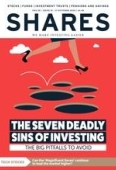Archived article
Please note that tax, investment, pension and ISA rules can change and the information and any views contained in this article may now be inaccurate.
Market unimpressed by Tesla’s hyped robotaxi event

The stock market was hungry for detail on Tesla’s (TSLA:NASDAQ) robotaxi launch timelines and regulatory roadblocks, but all it got was a slick film-set demonstration vague on vital information leaving investors barely any the wiser.
Elon Musk showcased Tesla’s ‘Cybercab’ during the company’s highly anticipated ‘We, Robot’ presentation (10 Oct), but investors were left underwhelmed and the stock plunged 9% post-event.
Cybercab is a fully autonomous car without a steering wheel or pedals, a wirelessly-charged (according to Musk) electric vehicle capable of moving people from point A to point B completely independent of a driver.
According to Musk, the Cybercab will be 10 to 20 times safer than ordinary cars and could cost as little as $0.20 to $0.30 per mile, far cheaper than the average $0.81 per mile it cost Americans to run a car in 2023, according to figures from the Financial Times.
Production, Musk promises, should begin between 2026 and 2027, although the Tesla chief executive has a history of over-egging delivery times.
In 2014, he promised Teslas would be capable of driving themselves within six years, and two years later he predicted a Tesla would drive itself from Los Angeles to New York without driver intervention within 12 months.
In May 2022, Musk claimed that achieving full autonomy was Tesla’s ‘number one priority’, while on the same earnings call admitting that full self-driving ‘was one of the hardest problems ever’.
Little wonder there remains an army of sceptics. ‘Tesla is not a player in the robotaxi market because they are prohibited from running on public roads’, said Dan O’Dowd, founder of safety advocacy group The Dawn Project.
‘Tesla is limited to yawn-inducing demonstrations in Hollywood studios while its competitors’ robotaxis transport 100,000 paying customers around major American cities every week.’
O’Dowd was referring to Google-owned Waymo, Alphabet’s (GOOG:NASDAQ) robotaxi service which already offers autonomous rides to ordinary people in San Francisco, Los Angeles, Phoenix and is launching services in Atlanta and Austin.
The massive robotaxi opportunity is to turn a vehicle from a one-time purchase driven 100,000 to 200,000 miles into a lifetime one-million-mile recurring revenue asset.
At the rough $1 per mile cost of public transport, it could turn a $30,000 Cybercab into a vehicle capable of producing $1 million in lifetime revenue. Whether that is a Tesla Cybercab or rival robotaxi remains a huge question.
Tesla shares have risen about 40% since announcing its robotaxi event, but they are still down 46% since their $407 peak in 2021.
Important information:
These articles are provided by Shares magazine which is published by AJ Bell Media, a part of AJ Bell. Shares is not written by AJ Bell.
Shares is provided for your general information and use and is not a personal recommendation to invest. It is not intended to be relied upon by you in making or not making any investment decisions. The investments referred to in these articles will not be suitable for all investors. If in doubt please seek appropriate independent financial advice.
Investors acting on the information in these articles do so at their own risk and AJ Bell Media and its staff do not accept liability for losses suffered by investors as a result of their investment decisions.
 magazine
magazine








